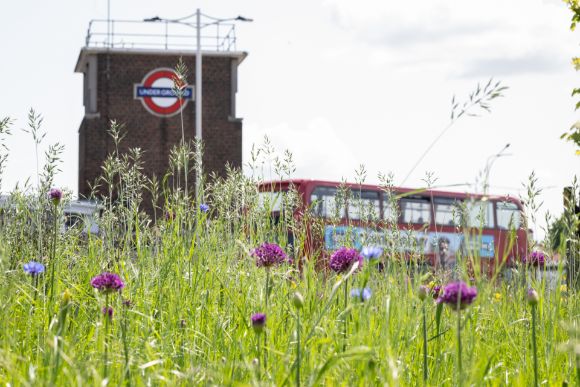London’s First Green Plant Academy Opens
A new facility to train the next generation in green construction skills has opened in Earls Court. The Green Plant Academy specialises in training on zero-emission...
Read Full Article
Transport for London has revealed how it will deliver a net gain in biodiversity across its estate, as one of London’s largest landowners.
The new Green Infrastructure and Biodiversity Plan brings together all of Transport for London’s (TfL) environmental targets and policy commitments for the first time. TfL pledges to deliver a net gain in biodiversity across its entire estate by 2030, compared to the 2018 biodiversity baseline map.
TfL’s estate is varied and diverse. It makes up over 2,300 hectares across the capital and almost a third of TfL’s land is covered by vegetation. TfL’s network also provides public access to several of London’s green spaces.
It was announced in January 2024 that developers building new housing, industrial or commercial developments will be subject to mandatory Biodiversity Net Gain rules. Biodiversity Net Gain will apply to major developments under the planning application route with ten or more dwellings, or where the site area is greater than 0.5 hectares.
Developers therefore must deliver tangible net gains, such as creating new wildlife habitats or investing in sustainable drainage.
TfL’s Biodiversity Net Gain plans focus on the following:
19 per cent of TfL’s land is covered by tree canopy, making it an impactful area to tackle as part of this plan. Most of these trees are on London’s streets and roadside woodland areas, and are at risk of climate change-related severe weather, high winds, drought and pests and diseases. Trees also reduce surface water flood risk and provide shade and cooling.
A tree canopy cover plan will be published by TfL by March 2025, which will outline how the body plans to increase tree canopy cover across its estate by 10 per cent by 2050, compared with the 2016 baseline.
In 2022, TfL embarked on a natural capital assessment of its entire estate, assessing inherently valuable assets that support biodiversity such as ecosystems, species, freshwater, soils, minerals, the air and oceans. As part of the new Green Infrastructure and Biodiversity Plan, TfL will maintain these records with updated analyses every four years.
Habitat loss from development is a key driver of biodiversity loss across the UK. TfL pledges to train its employees on integrating Biodiversity Net Gain into all projects and maintenance activities.
TfL uses aerial imagery to help calculate its estate’s biodiversity baseline, with images last produced in 2018. They are set to repeat this assessment in 2024.
30 per cent of TfL’s total green infrastructure is made up of grasslands – areas that are inhabited by rare plant and wildlife species and provide resources for pollinating insects.
After rolling out wildflower verges to almost 13 hectares of roadside verges in 2019, TfL plans to expand this coverage and include the planting of flower bulbs.
TfL aims to make Sustainable Drainage Systems, or SuDS the default in projects on TfL land. These systems reduce the flow of rainwater that reaches the city’s drainage networks. This is particularly crucial as London continues to experience more extreme weather.
The Green Infrastructure and Biodiversity Plan says that TfL is on track to install an additional 5,000 square metres of catchment draining into highway SuDS each year.
TfL pledges to better manage its sustainable resource use, including reducing peat and fuel use for green infrastructure planting and maintenance. They also promise to adapt to changes in climate which might affect the UK’s native plant species, potentially introducing new species, in line with its biosecurity policy.
The use of pesticides across TfL will be reduced or eliminated where operationally and financially feasible.
Improving access to green spaces also features in TfL’s biodiversity plans, both in terms of providing travel access and elements such as providing shade in hot weather. TfL plans to publish travel access maps which correlate with socio-economic factors by 2025.
To learn more about Biodiversity Net Gain – read the explainer article here.
Picture: a photograph showing some wildflowers growing on a grass verge. A London Underground station and a double decker bus can be seen in the background. Image Credit: TfL
Article written by Ella Tansley | Published 13 March 2024
A new facility to train the next generation in green construction skills has opened in Earls Court. The Green Plant Academy specialises in training on zero-emission...
Read Full ArticleBallymore has been selected as the joint venture partner for Places for London’s Limmo Peninsula project. Transport for London’s (TfL) commercial...
Read Full ArticleTo promote Clean Air Day, environmental activists have offered commuters on London Underground’s Victoria Line access to bottled air from the Lake District via...
Read Full ArticleNetwork Rail, Lambeth Council and Places for London have formed a new strategic partnership to lead on the regeneration of London Waterloo Station and the wider Southbank...
Read Full ArticleA smart sensor trial at Transport for London’s Stratford office is predicted to cut 40 tonnes of carbon dioxide emissions annually. The year-long pilot, a...
Read Full ArticleMore than 75 per cent of non-householder planning applications have claimed exemptions from Biodiversity Net Gain requirements since the policy came into effect in...
Read Full ArticleAs part of a £3 million five-year investment, Transport for London will improve and increase the number of accessible toilets on the network. The plan is...
Read Full ArticleTransport for London is working with the police to run training events to help empower people to safely take action when they encounter hate crime on the transport...
Read Full ArticleThe highest architectural accolade, the RIBA Stirling Prize, has been given to the Elizabeth Line. The RIBA Stirling Prize jury called it “a triumph in...
Read Full ArticleA consortium of businesses has signed an open letter to urge the Mayor of London to rethink ending congestion charge exemption for electric vans. Currently, 100 per...
Read Full Article